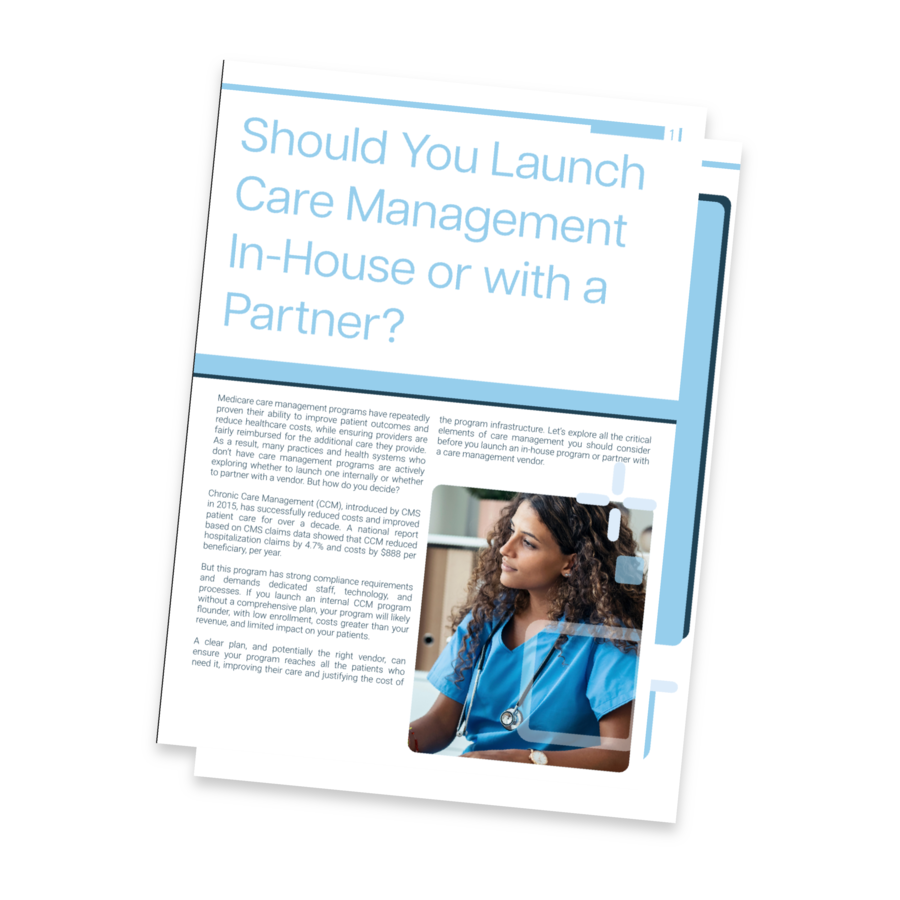
Talk with a ChartSpan Representative Today!
Our team is ready to help you improve patient care and outcomes.
Blog
Medicare Physician Fee Schedule Final Rule 2026: Significant Changes Are Coming
The Medicare Physician Fee Schedule Final Rule for 2026 includes changes to Chronic Care Management (CCM), Advanced Primary Care Management (APCM), and Remote Patient Monitoring (RPM); a reduction in facility reimbursement rates; a mandatory new reimbursement model for providers who treat back pain or heart failure; and shifts in the Merit Incentive Payment System (MIPS) and Medicare Shared Savings Programs (MSSP).
Finally, increased reimbursements for Medicare providers
The 2026 PFS Final Rule includes reimbursement increases for most Medicare E&M encounters, an encouraging sign for practices and health systems facing uncertain funding.
President Trump’s “One Big Beautiful Bill Act” includes a 2.5% reimbursement increase for most Medicare services, including CCM, APCM and RPM. In addition to that increase, the PFS allots an additional increase of 1.24% for Medicare providers who participate in any Alternative Payment Model (APM) and a 0.74% increase for Medicare providers who are not participating in an APM. This includes an RVU increase for both and a slightly higher base update for APM participants.
The higher rate for APM participants is a further nudge by CMS that they want all providers participating in Value-Based care arrangements and taking on risk.
The pay bump follows five consecutive years of Medicare reimbursement cuts, which physician groups and lobbyists have long warned would force practice closures and threaten patient access, especially as the nation grapples with workforce shortages, hospital closures, and rising rates of chronic disease.
For providers in an APM, the 2026 reimbursement increase will total 3.77% and for non- APM providers a 3.26% overall increase.
Addition of behavioral health codes to Advanced Primary Care Management
As ChartSpan predicted last year when APCM was created, CMS is integrating BHI into APCM, but in an unexpected manner. CMS is creating optional add-on codes for Advanced Primary Care Management (APCM) services. This would allow for the payment of APCM and BHI/CoCM for the same patient, in the same month.
CMS proposes that the services included in the add-on codes will be similar to the services of existing BHI and CoCM codes, like 99484 (general BHI) and 99492, 99493, and 99494 (CoCM). The add-on codes are:
GPCM1: similar services to 99492
GPCM2: similar services to 99493
GPCM3: similar services to 99484
These new behavioral health codes are specifically designed to facilitate the provision of complementary Behavioral Health Integration (BHI) or psychiatric Collaborative Care Model (CoCM) services. The new G-codes are intended to be billed as add-on services when the APCM base code is reported by the same practitioner within the same month. These add-on codes are structured to be directly comparable to existing CoCM and BHI codes, ensuring consistency and clarity in billing.
Optional add-on G-codes for APCM demonstrates CMS's commitment to integrating mental health and substance use disorder treatment within primary care. By making these add-on codes optional yet comparable to existing codes, CMS offers a flexible mechanism for primary care practices to enhance their behavioral health services without imposing a rigid model. This approach recognizes the substantial influence of behavioral health on overall chronic disease management and patient outcomes. It provides an incentive for primary care practices to develop or strengthen their capabilities for integrated behavioral health, potentially leading to earlier interventions, improved patient access to mental health services, and better-managed chronic conditions. This also indicates an understanding that a fragmented approach to physical and mental health care is inefficient and can negatively impact patient well-being.
It’s important to note that general BHI and the psychiatric CoCM have different requirements. While a provider and care manager can collaborate with the patient on general BHI, CoCM requires that the care team also include a specialized psychiatric consultant. CoCM therefore requires more resources and infrastructure.
However, both general BHI and psychiatric CoCM have features that can help providers deliver whole-person, comprehensive care to their APCM patients. Therefore, the new add-on codes offer exciting opportunities for primary care, family medicine, and geriatric medicine providers.
Billing changes for Rural Health Clinics and Federally Qualified Health Centers
Code G0511, the general care management code for RHCs and FQHCs, officially sunsetted on September 30, 2025. The 2026 Final Rule continues the push for FQHCs and RHCs to bill more of their care management services separately.
Starting in 2026, FQHCs and RHCs will be able to join traditional practices in billing optional APCM add-on codes for general BHI and psychiatric CoCM. Additionally, RHCs and FQHCs will report the individual codes for Communications Technology-Based Services (G0512) and Remote Evaluation Services (G0071).
RHCs and FQHCs also have the ability to report Remote Therapeutic Monitoring (RTM) and Remote Patient Monitoring (RPM) codes separately during the same month they report APCM, if a patient receives both.
Reporting individual codes and add-on codes will be essential for RHCs and FQHCs who struggle to generate enough revenue to continue serving their patients. By offering APCM with BHI or CoCM and billing G0512 and G0071, RHCs and FQHCs can offset some of the losses caused by the sunset of G0511.
Mandatory Care Management APM for Heart Failure and Back Pain
CMS has created a new Advanced Alternative Payment Model, called the Ambulatory Speciality Model (ASM), that will launch in 2027. This model will target specialists in general cardiology who treat heart failure and specialists in anesthesiology, pain management, neurosurgery, orthopedic surgery, and physical rehabilitation who treat lower back pain.
ASM is a mandatory, five-year payment model, scheduled to begin on January 1, 2027, and run through December 31, 2031, with final data submitted in 2032 and payment adjustments in 2033. It is a two-sided risk program. The ASM's core objectives are multifaceted:
- To hold specialists financially accountable for managing chronic conditions, specifically heart failure (HF) and low back pain.
- To improve prevention and upstream management of chronic disease, leading to reductions in avoidable hospitalizations and unnecessary procedures.
- To enhance the quality of care by rewarding specialists for effective disease management, adherence to clinical guidelines, and coordination with other providers involved in patient care.
- To improve patient experience and outcomes while lowering costs to Original Medicare.
For heart failure, participants will primarily be physicians specializing in general cardiology. Notably, interventional cardiology will not be selected for the model.
For low back pain, the model includes a broader range of specialists: anesthesiology, pain management, interventional pain management, neurosurgery, orthopedic surgery, and physical medicine and rehabilitation.
To be eligible, specialists must have historically treated at least 20 Part B Medicare patients with heart failure or low back pain episodes per year, as identified by episode-based cost measure methodology.
Remote Patient Monitoring and Remote Therapeutic Monitoring Billing Codes
In 2026, there will be a new RPM and a new RTM code, each of which will apply to 2-15 days of transmitted data. The existing codes, 99454 (RPM), 98976 (RTM–respiratory), 98977 (RTM–musculoskeletal), and 98978 (RTM–cognitive behavioral therapy), will be adjusted to apply to 16-30 days of transmitted data.
CMS is also altering the time requirements for clinical time spent on RPM and RTM patients. The time requirement will be cut down from 20 initial minutes to 11-20 initial minutes for codes 99457 (RPM) and 98980 (RTM). Clinicians can also bill for 10 minutes of additional time spent with patients, rather than waiting until they reach 20 additional minutes, under codes 99458 (RPM) and 98981 (RTM).
Reducing these time requirements suggests that CMS is open to more targeted, shorter sessions of RPM and RTM, both for data collection and for clinical support.
Though CMS has announced that an efficiency reduction will apply for some services, it will not apply for RPM, or for other care management services like Chronic Care Management (CCM) and APCM. However, RPM may be affected by a reduction in rates based on where services are offered.
Facility Reduction Rates
RVUs applied to remote care programs, like CCM, APCM and RPM, historically relied on facility rates that were specific to office-based or specialty practice settings. CMS has now decided to reduce these rates for programs that don’t require these settings. The facility reduction in rates could therefore impact care management reimbursements.
Virtual Direct Supervision
When providers are required to offer direct supervision, they can now do so virtually, as long as the virtual supervision is in real time. This won’t directly impact CCM, APCM, or RPM, since those programs can be performed under general supervision, incident to, but could increase other opportunities for remote healthcare.
Changes to MIPS and MVPs
CMS has announced major changes to MIPS in 2026. The performance threshold for MIPS will remain at 75 points–however, quality, cost, improvement activities, and promoting interoperability will all see changes. Under quality, MIPS quality measures will be aligned with APM performance plus quality measures. This will include removing ten current MIPS measures and replacing them with five measures more focused on chronic illness. MIPS will also now include a longitudinal measure, the Patient Activation Measure (PAM), which measures a patient’s participation and engagement in their care over the long term.
30 measures were also modified in terms of their technical specifications and scoring methodology. No new cost measures will be added, but CMS proposes a two-year testing period before new cost measures are factored into performance. For improvement activities, CMS will remove the Achieving Health Equity subcategory and replacie it with the subcategory Advancing Health and Wellness. Eight measures could be removed, seven modified, and three added. Notably, Screening for Social Drivers of Health, an often-used quality measure, will be removed.
Under Promoting Interoperability, the need for electronic case reporting will be removed, but Security Risk Analysis and SAFER Guide attestations will be expanded. Because the changes to MIPS are extensive, ChartSpan highly recommends consulting with a quality specialist on how they will impact your practice.
CMS will also introduce six new MIPS Value Pathways (MVPs) for 2026, including diagnostic radiology, interventional radiology, neuropsychology, pathology, podiatry and vascular surgery, and will add modifications to the 21 existing MVPs. CMS did not state when all MIPS providers will be required to switch to MVPs, but did ask for feedback on what future year would be practical for this switch.
Changes to Medicare Shared Savings Program
CMS has also announced changes to the Medicare Shared Savings Program. Providers in MSSP will now only be able to stay in one-sided risk arrangements (payment bonuses, but not penalties), for five years instead of seven. Participants will also only be required to have 5,000 attributed Medicare beneficiaries in the third year of participation, not the first two. These changes will take effect in 2027.
Cyberattacks will be added to the list of Extreme and Uncontrollable Circumstance Policies (EUC) in 2025. The definition of “primary care services” used to assign beneficiaries to the ACO will also be expanded, and the Health Equity adjustment will be removed in 2026. The health equity benchmark adjustment will be renamed to “population adjustment.”
Overall, CMS seems to be making it easier for providers to join ACOs or APMs and accept two-sided risk. If you’re wondering about the right path forward for your practice, a quality specialist can help you navigate these changes, whether your practice has chosen MIPS, MVPs, MSSP, or another ACO or APM.
Requests for Information for Future Planning
CMS also issued a few Requests for Information, which may impact Proposed and Final Rules in future years, though they won’t impact 2026. These include a request for feedback on the idea of bundling preventive care services under APCM, which could lead to APCM no longer having cost-sharing for patients, and the idea of giving ACOs capitation payments for offering APCM services.
While practices considering or offering APCM don’t need to prepare for these changes immediately, the Requests for Information seem to indicate that CMS is interested in expanding APCM and encouraging more practices to participate.
Preparing for the Changes in the Final Rule
With the announcement of the Final Rule, practices must begin preparing for 2026 to protect their revenue and ensure consistent patient care.
The conversion factor will increase. Nevertheless, providers should consider actively seeking new sources of revenue, such as Advanced Primary Care Management with optional BHI or CoCM services added on.
Rural Health Clinics and Federally Qualified Health Clinics can adjust to the sunset of G0511 by embracing APCM, with its potential add-on codes, or by choosing other care management services and billing each of them separately where allowed. RHCs, FQHCs, and traditional practices can also consider Remote Patient Monitoring and Remote Therapeutic Monitoring as possibilities, especially with more flexible billing codes.
If you’d like to learn more about the changes included in the Final Rule, especially changes around care management programs, you can sign up for ChartSpan’s Final Rule webinar, where we’ll dive deeper into what the 2026 changes to the PFS will mean for practices.
Resources
Subscribe for More Insights
Get valuable resources delivered straight to your inbox.
"*" indicates required fields






